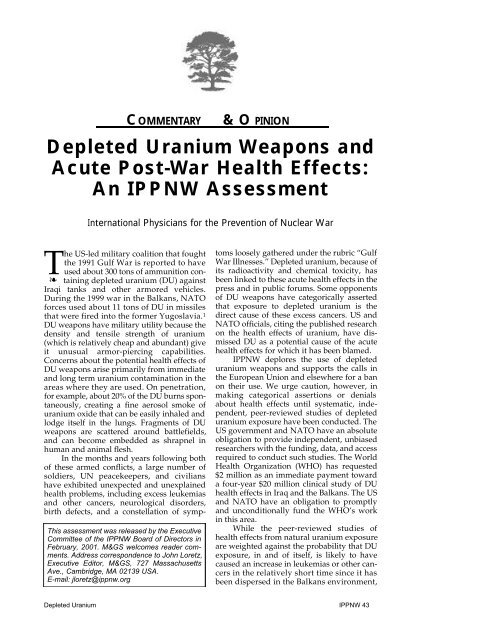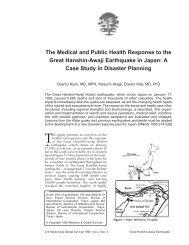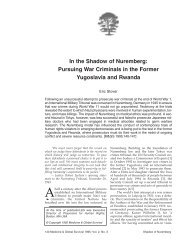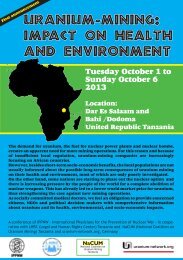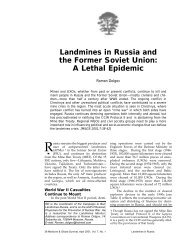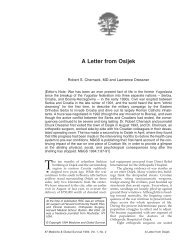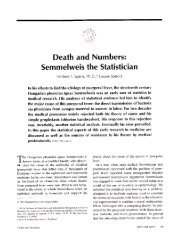Depleted Uranium Weapons and Acute Post-War Health Effects: An ...
Depleted Uranium Weapons and Acute Post-War Health Effects: An ...
Depleted Uranium Weapons and Acute Post-War Health Effects: An ...
You also want an ePaper? Increase the reach of your titles
YUMPU automatically turns print PDFs into web optimized ePapers that Google loves.
C O M M E N T A R Y& O P I N I O N<strong>Depleted</strong> <strong>Uranium</strong> <strong>Weapons</strong> <strong>and</strong><strong>Acute</strong> <strong>Post</strong>-<strong>War</strong> <strong>Health</strong> <strong>Effects</strong>:<strong>An</strong> IPPNW AssessmentInternational Physicians for the Prevention of Nuclear <strong>War</strong>This assessment was released by the ExecutiveCommittee of the IPPNW Board of Directors inFebruary, 2001. M&GS welcomes reader comments.Address correspondence to John Loretz,Executive Editor, M&GS, 727 MassachusettsAve., Cambridge, MA 02139 USA.E-mail: jloretz@ippnw.orgThe US-led military coalition that foughtthe 1991 Gulf <strong>War</strong> is reported to haveused about 300 tons of ammunition containingdepleted uranium (DU) against❧Iraqi tanks <strong>and</strong> other armored vehicles.During the 1999 war in the Balkans, NATOforces used about 11 tons of DU in missilesthat were fired into the former Yugoslavia. 1DU weapons have military utility because thedensity <strong>and</strong> tensile strength of uranium(which is relatively cheap <strong>and</strong> abundant) giveit unusual armor-piercing capabilities.Concerns about the potential health effects ofDU weapons arise primarily from immediate<strong>and</strong> long term uranium contamination in theareas where they are used. On penetration,for example, about 20% of the DU burns spontaneously,creating a fine aerosol smoke ofuranium oxide that can be easily inhaled <strong>and</strong>lodge itself in the lungs. Fragments of DUweapons are scattered around battlefields,<strong>and</strong> can become embedded as shrapnel inhuman <strong>and</strong> animal flesh.In the months <strong>and</strong> years following bothof these armed conflicts, a large number ofsoldiers, UN peacekeepers, <strong>and</strong> civilianshave exhibited unexpected <strong>and</strong> unexplainedhealth problems, including excess leukemias<strong>and</strong> other cancers, neurological disorders,birth defects, <strong>and</strong> a constellation of symptomsloosely gathered under the rubric “Gulf<strong>War</strong> Illnesses.” <strong>Depleted</strong> uranium, because ofits radioactivity <strong>and</strong> chemical toxicity, hasbeen linked to these acute health effects in thepress <strong>and</strong> in public forums. Some opponentsof DU weapons have categorically assertedthat exposure to depleted uranium is thedirect cause of these excess cancers. US <strong>and</strong>NATO officials, citing the published researchon the health effects of uranium, have dismissedDU as a potential cause of the acutehealth effects for which it has been blamed.IPPNW deplores the use of depleteduranium weapons <strong>and</strong> supports the calls inthe European Union <strong>and</strong> elsewhere for a banon their use. We urge caution, however, inmaking categorical assertions or denialsabout health effects until systematic, independent,peer-reviewed studies of depleteduranium exposure have been conducted. TheUS government <strong>and</strong> NATO have an absoluteobligation to provide independent, unbiasedresearchers with the funding, data, <strong>and</strong> accessrequired to conduct such studies. The World<strong>Health</strong> Organization (WHO) has requested$2 million as an immediate payment towarda four-year $20 million clinical study of DUhealth effects in Iraq <strong>and</strong> the Balkans. The US<strong>and</strong> NATO have an obligation to promptly<strong>and</strong> unconditionally fund the WHO’s workin this area.While the peer-reviewed studies ofhealth effects from natural uranium exposureare weighted against the probability that DUexposure, in <strong>and</strong> of itself, is likely to havecaused an increase in leukemias or other cancersin the relatively short time since it hasbeen dispersed in the Balkans environment,<strong>Depleted</strong> <strong>Uranium</strong> IPPNW 43
The US government<strong>and</strong> NATO have anobligation to provideunbiased researcherswith the funding, data,<strong>and</strong> access to conducthealth studies.the science is controversial <strong>and</strong> the possibilitycannot be ruled out. The Office of the SpecialAssistant for Gulf <strong>War</strong> Illnesses, whichreports to the US Department of Defense, hasitself stated that DU can pose a chemical toxicity<strong>and</strong> radiological hazard under specificconditions. 2 Moreover, any impurities thatmay have found their way into the DU munitionsused in either the Gulf or the Balkans—including plutonium, actinides, <strong>and</strong> the highlyradioactive manufactured isotope U-236 3 —pose unquestionably serious health threats,<strong>and</strong> the extent to which at-risk populationsmay have been exposed to these substancesmust be studied promptly <strong>and</strong> thoroughly byunbiased investigators.Allied soldiers <strong>and</strong> Iraqi soldiers <strong>and</strong>civilians were exposed to many other healthhazards before, during, <strong>and</strong> after the Gulf<strong>War</strong>. These included multiple vaccines, insecticides,<strong>and</strong> chemical weapon protectives.<strong>An</strong>y chemical weapons released as a result ofthe bombing of Iraqi munitions-dumpswould be anadditional hazard (as wouldchemical weapon residuesfrom the prior Iran-Iraq war).The petrochemical fires thatraged for weeks at the conclusionof the war added to thetoxic burden. In the formerYugoslavia, chemical factorieswere targeted <strong>and</strong>destroyed during NATO airstrikes, <strong>and</strong> large amounts of toxic chemicals,some of them known carcinogens, werereleased. Risk factors can interact (e.g., smokingcompounds the risk of radiation exposureamong uranium miners).The British Medical Journal, in a recenteditorial, concluded that “the argument foruranium being the cause of leukaemia inpeacekeeping forces is thin, notwithst<strong>and</strong>ingthe short latencies implied, even by the st<strong>and</strong>ardsof haematological malignancies,” <strong>and</strong>that, with regard to non-cancer illnesses, “nosingle c<strong>and</strong>idate hazard...serves as its unifyingexplanation, depleted uranium included.” 4 Topoint to these other exposures as possiblecontributors to post-war health problems isnot to exonerate DU weapons in the absenceof independent clinical study of the populationsthat were actually exposed.<strong>Depleted</strong> <strong>Uranium</strong>:The Facts in BriefNatural uranium is composed of threeisotopes: U-238 (99.3%), U-235 (0.7%), <strong>and</strong> U-234 (0.006%). These isotopes decay at differentrates, expressed in scientific parlance ashalf lives. A shorter half life means moreintense radiation <strong>and</strong>, in general, greaterpotential to damage or destroy cells. The halflife of U-238—the time in which its radioactivityis reduced by half—is 4.5 billion years;that of U-235 is 710 million years; <strong>and</strong> that ofU-234 is 250 thous<strong>and</strong> years. For comparison,the half life of plutonium—which can belethal in even microscopic amounts—is24,000 years. 5<strong>Depleted</strong> uranium is the byproduct of aprocess known as uranium enrichment—themanufacture of uranium with a concentrationof highly radioactive U-235 for use innuclear weapons <strong>and</strong> in nuclear powerplants. DU, which has been depleted of its U-235 <strong>and</strong> U-234, is about 60% as radioactive asnatural uranium. Most of that radiation—about 95%—is emitted as alpha particles thatcannot penetrate the skin. A minute amountof beta <strong>and</strong> gamma radiation could strikedeeper cell tissue were fine particles of DUinhaled or ingested, as they could easily beby any soldier or civilian in the vicinity of arecently exploded DU shell. Even low dosesof low-level radiation can cause some damageto the DNA in living cells. Whether thatdamage is enough to significantly increasethe risk of cancer <strong>and</strong> other acute healtheffects is a matter of much debate, <strong>and</strong> upuntil now there has been no conclusive evidenceof adverse health effects from exposureto natural uranium. We cannot emphasizestrongly enough, however, that an absence ofevidence about health effects is not evidencethat there are no health effects.DU is no different from natural uraniumin its chemical toxicity. It is a heavy metalthat, in its soluble form, accumulates in thekidneys (the primary target organ for uranium)<strong>and</strong> that, in sufficient quantities, canincrease the risk of renal damage. The scientificevidence to date suggests that ingestionof uranium, even in unusual amounts, doesnot by itself cause serious or enduring healthproblems due to chemical toxicity.Nevertheless, like all heavy metals, DU is arisk factor that cannot be casually dismissed.<strong>Uranium</strong> <strong>Health</strong> StudiesStudies conducted over several decadeshave found that populations with wellabove-averageoccupational exposure toinhaled or ingested uranium do not sufferfrom increased rates of the cancers most likelyto be associated with radiation, nor do theyexhibit the blood disorders that might beexpected as a result of chemical toxicity.Other causes, such as radon exposure amonguranium miners <strong>and</strong> mill workers, have beenpinpointed for certain specific illnesses, 6,7 butthese studies do not account for new experimentaldata suggesting a role for dust toxicityin the lung. The aerosol particles generatedby DU weapons are in a very hard “ceramic”state, so are likely to be retained in the lung44 Medicine & Global Survival, April 2001; Vol. 7, No. 1 <strong>Depleted</strong> <strong>Uranium</strong>
<strong>and</strong> its regional lymph nodes for a prolongedperiod, increasing the risk of cellular damagefrom alpha radiation. The main risk frominternal radiation, whether the exposure isdue to manufacturing processes or DUweapons, is from this inhaled dust.As mentioned earlier, there is evidencethat the DU munitions used in the Gulf war<strong>and</strong> in the Balkans were tainted with plutonium,U-236, <strong>and</strong> other substances far moreintensely radioactive than U-238. Recent studieshave pointed to the possiblility of geneticdamage resulting from exposure to someforms of radiation emitted from particles suchas those deposited by DU weapons. 8 A n ysuch genomic effect, if substantiated, couldpoint toward increased risk of cancer orleukemia in the lung or regional lymph nodesabove the st<strong>and</strong>ard—<strong>and</strong> controversial—predictionsof radiation protection models. 9 It issimply too early to say. Precisely for that reason,the health of military <strong>and</strong> civilian populationsthat have been exposed to DU in theGulf <strong>and</strong> in the Balkans should be monitoredclosely in the years ahead.What Should Be DoneAbout DU <strong>Weapons</strong>?While IPPNW generally concurs withthe BMJ’s assessment that the jury is still outon DU, <strong>and</strong> that the other hazards to whichcivilians <strong>and</strong> military personnel were exposed,individually <strong>and</strong> in combination, are themselvesvery likely causes of the kinds of postwarhealth problems from which civilians<strong>and</strong> military personnel have been suffering inthe aftermath of these conflicts, we condemnthe use of DU weapons <strong>and</strong> support the callsfor a ban on their use.A basic principle in radiation protectionis that all exposures should be justified; thatis, the benefit for those exposed shouldexceed the risk. This is the st<strong>and</strong>ard for medicalradiography. The military utility of DUweapons for the users does not justify anyadded health risk for non-combatants, nomatter how small. The precautionary principlestates that in the absence of convincingproof that a substance or process is harmless,the presumption must be risk. This principleapplies clearly to the use of DU weapons.Furthermore, DU weapons indiscriminatelycontaminate the places in which they areused, <strong>and</strong> the contamination persists longafter the conclusion of hostilities, adding tothe radioactive <strong>and</strong> toxic burden imposedupon civilians, wildlife, <strong>and</strong> ecosystems.From this perspective, DU weapons shouldbe considered a form of ecological warfareprohibited by the Geneva Conventions. 10DU weapons may already be illegalunder international law <strong>and</strong> internationalhumanitarian law, <strong>and</strong> this case is beingmade in compelling fashion by members ofthe International Association of LawyersAgainst Nuclear Arms (IALANA), who haveformed a working group to study this issue.The damage caused by DU weapons cannotbe contained to “legal” fields of battle; theycontinue to act after the conclusion of hostilities;they are inhumane because they placethe health of non-combatants, including children<strong>and</strong> future generations, at risk; <strong>and</strong> theycannot be used without unduly damagingthe natural environment. 11The fact that military authorities in boththe US <strong>and</strong> NATO advise their own soldiersto take precautions when h<strong>and</strong>ling DU munitions<strong>and</strong> have prepared detailed trainingmanuals <strong>and</strong> videos to ensure troop safety. 12while issuing blanket denials of health risksto the public, strikes us as hypocritical at thevery least, <strong>and</strong> reinforces our judgment thatthese weapons should be withdrawn fromservice.Whether or not DU weapons are ultimatelyshown to have the health effects forwhich they have been blamed, they are onlyone example of the continuing ways in whichmilitaries pollute our planet. They are emblematicof the unacceptable costs of contemporaryarmed conflict to civilian populations,who were the predominant casualties of warin the 20th century, <strong>and</strong> are likely to remainso in the 21st. They are on the spectrum ofindiscriminate <strong>and</strong> inhumane weapons thatincludes l<strong>and</strong>mines <strong>and</strong> biological <strong>and</strong> chemicalweapons, <strong>and</strong> that, at its most devastatingend, includes tens of thous<strong>and</strong>s ofnuclear weapons that jeopardize all life onEarth.❧References1. Spellar J. Statement by the minister for thearmed forces on depleted uranium. UK:Ministry of Defence. 9 January 2001.2. Special Assistant for Gulf <strong>War</strong> Illnesses.Environmental exposure report: <strong>Depleted</strong> uraniumin the Gulf. Washington, DC: Departmentof Defense. 1998.3. UN Environment Programme. UNEP confirms<strong>Uranium</strong> 236 found in DU penetrators.Geneva: UNEP. 16 January 2001.4. McDiarmid MA. <strong>Depleted</strong> uranium <strong>and</strong>public health: Fifty years’ study of occupationalexposure provides little evidence of cancer(Editorial). BMJ 2001;322. 20 January 2001.5. IPPNW, IEER. Plutonium: Deadly gold of thenuclear age. Cambridge, MA: InternationalPhysicians Press. 1992.6. Harley NH, Pasternack BS. A model for predictinglung cancer risks induced by environmentallevels of radon daughters. <strong>Health</strong> Phys1981;40:307-316.7. Harley NH. Radon <strong>and</strong> lung cancer in mines<strong>and</strong> homes. N Engl J Med 1984;310:1525-1527.8. Kadhim MA, Macdonald DA, Goodhead<strong>Depleted</strong> <strong>Uranium</strong> IPPNW 45
DT, Lorimore SA, Marsden SJ, Wright EG.Transmission of chromosomal instability afterplutonium-particle irradiation. Nature1992;355:738-40.9. Köhnlein W, Nussbaum RH. False alarm orpublic health hazard?: Chronic low-dose externalradiation exposure. Medicine & GlobalSurvival 1998;5:14-21.10. Protocol additional to the Geneva conventionsof 12 August 1949, <strong>and</strong> relating to the protectionof victims of international armed conflicts(Protocol I). Section IV, Article 55.11. Parker K. Conference statement.International conference: campaign againstdepleted uranium. Manchester, UK. 4-5November 2000.12. US Army. Contaminated <strong>and</strong> damagedequipment management operations (trainingvideo). 1995.❧ ❧ ❧<strong>Depleted</strong> <strong>Uranium</strong>:Some Other PerspectivesDU Not A High Priority for<strong>An</strong>tinuclear MovementTwo years ago, members of antinuclearweaponsgroups began to ask our viewsabout the alarm raised by the InternationalAction Center in its book, Metal of Dishonor,about the use of depleted uranium (DU) penetratorsin anti-armor munitions. 1 We wereasked whether the hazard was so great thatactivists should give priority to banning DU.We read Metal of Dishonor <strong>and</strong> foundthat, despite the contributions of physicists<strong>and</strong> radiation-effects analysts, it contained noquantitative risk estimate. We therefore decidedto provide the best one we could, usinginformation available in the literature aboutthe health effects of uranium <strong>and</strong> ionizingradiation.We concluded that, except for soldiers invehicles when they are struck, or individualswho crawl around inside such vehicles withoutadequate respiratory protection forextended periods of time later on, the healtheffects of DU are likely to be very small. Theradiation effects would be well below thoseof natural background radiation <strong>and</strong> thechemical effects would be well below thethresholds for known toxic effects. 2Contaminated armored vehicles <strong>and</strong> piecesof depleted uranium, however, are potentialhazards <strong>and</strong> should be cleaned up orburied—something which was not done inmost cases after Desert Storm <strong>and</strong> is onlybeing done now in Kosovo.IPPNW’s statement does not disagreewith our conclusion—nor similar conclusionsthat have been arrived at by every peerreviewedstudy of which we are aware. Itargues, however, for a ban on the use of DUon the basis that “the military utility of DUweapons for the users does not justify anyadded health risk for non-combatants, nomatter how small.” Of course, no weaponwould pass such a test. The IPPNW statementis therefore not helpful in answeringthe question: “How important is this issuerelative to all the others confronting the antinuclear-weaponsmovement?”The IPPNW statement urges that “thehealth of military <strong>and</strong> civilian populationsthat have been exposed to DU in the Gulf <strong>and</strong>in the Balkans should be monitored closely inthe years ahead.” In our view, this would beuseful only for populations for which there isquantitative evidence of significant DU exposure.The best evidence is obtainable throughurine tests. It is not too late to conduct suchmeasurements for soldiers or civilians whobelieve they have been exposed to DU in theBalkans. Samples collected from 171 Germansbefore <strong>and</strong> after their service in Kosovoshowed no increase in uranium concentration.3 There is no justification for a full-scaleepidemiological study of such a population.The IPPNW statement also raises theissue “that the DU munitions used in the Gulfwar <strong>and</strong> in the Balkans were tainted withplutonium, U-236, <strong>and</strong> other substances farmore intensely radioactive than U-238.”Here again, a quantitative perspective wouldbe useful. The dose from inhaled DU contaminatedwith 1 part per million (ppm) plutoniumor 0.3% U-236 would be about 50%greater than the dose from an equal amountof uncontaminated DU. The maximum contaminationmeasurements that we have seenare about an order of magnitude lower thanthese levels; concentrations measured in samplesof DU metal used for tank armor areseveral orders of magnitude lower. †4In summary, the IPPNW statement pro-† <strong>An</strong> Oak Ridge study found that the highestratios of U-236/U-235 <strong>and</strong> Pu-239/U-238 in thesolid “heels” left in containers of the enricheduranium hexafluoride produced by the Paducahenrichment plant, where uranium from US plutonium-productionreactors was enriched, correspondrespectively to 0.01% U-236 <strong>and</strong> 0.1 ppmPu-239 in DU containing 0.2% U-235.46 Medicine & Global Survival, April 2001; Vol. 7, No. 1 <strong>Depleted</strong> <strong>Uranium</strong>
vides no basis to change our conclusions:1) The health risks from DU are notgreat enough to make efforts to ban its use ahigh priority for the anti-nuclear-weaponsmovement; but2) DU-contaminated vehicles <strong>and</strong>pieces of DU on the battlefield should neverthelessbe removed or buried to minimizeexposure to those who subsequently may livein or visit the area.—Steve Fetter, PhD,Frank N. von Hippel, PhDReferences1. Caldicott H, Kaku M, Gould J, Clark R.Metal of dishonor: how depleted uranium penetratessteel, radiates people <strong>and</strong> contaminatesthe environment. New York: InternationalAction Center. 1997.2. Fetter S, von Hippel F. The hazard posed bydepleted-uranium munitions. Science <strong>and</strong>Global Security 1999;8:125–161. Availableonline at www.princeton.edu/~cees/arms/SciGloSec.shtml.3. Roth P, Werner E, Paretzke HG. Untersuchungenzur uranausscheidung im urin.Available online at www.gsf.de/Aktuelles/Presse/uran.pdf.4. Hightower JR, O’Connor DG, Dole LR,Pawel SJ, Lee DE, Schmoyer RL, et al. Strategyfor characterizing transuranics <strong>and</strong> technetiumcontamination in depleted UF6 cylinders(ORNL/TM-2000/242). Oak Ridge, Tennessee:Oak Ridge National Laboratory. 2000. Online atwww.public.usit.net/dolelj/ ORNL-TM-2000-242.pdf.SF is Professor of Public Affairs at the Universityof Maryl<strong>and</strong>; FNvH is Professor of Public <strong>and</strong>International Affairs at Princeton University.<strong>Depleted</strong> <strong>Uranium</strong> <strong>and</strong> theGeneva ConventionsThe statement on depleted uranium by theexecutive committee of IPPNW is balanced<strong>and</strong> useful. I have difficulties, however,with the statement that the use of DUweapons should be considered “a form ofecological warfare prohibited by the GenevaConventions.” Article 55 of Protocol I to theGeneva Conventions (1977) prohibits “theuse of methods or means of warfare whichare intended or may be expected to causesuch damage to the natural environment <strong>and</strong>thereby to prejudice the health or survival ofthe population.”I have not found reliable evidence forthe assumption that the areas contaminatedwith DU will be unsuitable for human habitationor agriculture because of the radioactivity.The increase in background radiationto which the population will be subject isnegligible. The remaining weapons containingDU are more of a concern. Children arelikely to play in the ab<strong>and</strong>oned tanks containingsubstantial amounts of DU in theform of fine hard dust, <strong>and</strong> may collect shells<strong>and</strong> fragments containing of DU. The tanks<strong>and</strong> ammunition should be collected <strong>and</strong>removed.Like lead, uranium is taken up <strong>and</strong> circulatedin the ecosystems to a very limiteddegree. The chemical toxicity of the heavymetal uranium is somewhat similar to that oflead. In many countries children have sufferedbrain damage after eating lead in flakingpaint in houses. While uranium inartillery shells is much harder than lead <strong>and</strong>the chances of ingestion are smaller, chemicaltoxicity is a consideration.A careful study has been published on29 US soldiers who were exposed to “friendlyfire” that destroyed 15 US tanks in the Gulfwar, <strong>and</strong> who were examined seven yearslater. 1 These servicemen carry DU in theirbodies as dust or as fragments in amountsmuch larger than can be expected for thecivilian population. Despite this, the increasein radioactivity in their bodies was far belowthe level contributed by the background.Very sensitive indicators of kidney damagewere normal. In one of several tests for cognitivefunction there was some degree of dysfunction.Physicians are on safe ground when wedem<strong>and</strong> that DU should not be used inweapons until its possible chemical <strong>and</strong>physical toxicity is better known. We have,however, no evidence that DU is causingenvironmental danger of a type <strong>and</strong> degreecovered by the Geneva Conventions.—Gunnar Westberg, MDSwedenReference1. McDiarmid M et al. Environ Res Sect A2000;82:168-180.GW is President of Svenska Lakare motKarnvapen (SLMK—IPPNW Sweden).<strong>Depleted</strong> <strong>Uranium</strong> von Hippel/Fetter/Westberg 47


